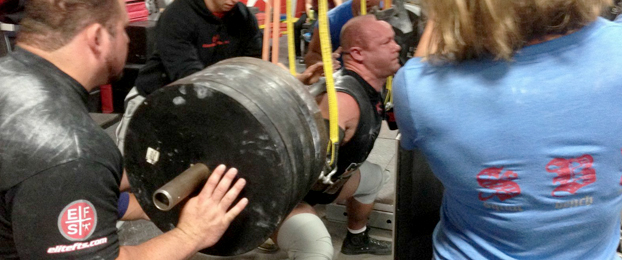
Getting ready for a big meet is stressful. There are a lot of things to consider, especially when using equipment. I am not going to write out all of my workouts, but I am going to give you a few points that I have learned over the last 20 years, and hopefully you can avoid some of my mistakes. Then again we are a bunch of hard headed powerlifters so who knows. This is based on a 16 week program.
The First 5 Weeks
The first five weeks should be a time to increase speed, while increasing your workload to develop your GPP for the heavy workouts to come. A sled is a great way to increase your GPP. This can be done after every workout. I am going to get a Prowler which is a type of sled that you push. This is also great for football players, or in my case a bobsledding girlfriend. I also do a lot of mini workouts that target weak spots, and I am going for some hypertrophy. For example, a workout may consist of:
- Lat Pulldowns – 3 sets of 10 reps
- Weighted Sit-ups – 3 sets of 8-12 reps
- Pull Throughs – 3 sets of 10-20 reps
During this time, I will use lots of band tension with lighter weight. An example of a squat workout would be:
- 8 sets of 2 reps @ 35% with 2 strong bands and 1 average band/side
An example of a bench press workout would be:
- 6 sets of 3 reps @ 40% with bands - The bands vary quite a bit. I use anywhere between two mini-bands per side to a doubled average band.
For the deadlift I will do 6 singles at around 40%.
The Next 8 Weeks
The next eight weeks is the heavy time. Equipment should be used every week to master its application. It has really worked well with me to rotate a type of heavy squat/DL every other week.
- Week 1: Chain squats – These are done 2 inches high with 102% of my 1RM.
- Week 2: Cambered Bar Box Squat – 2 sets of 5 reps @ 60%. I will then do some kind of deadlift. This is done for a max triple. An example would be a deadlift while standing on a 4” box.
Notice that on week one, I am going heavy on a squat and am not pulling. On week two, I squat light and pull heavy. This has worked great for me.
Here are some other notes on this 8 week period.
- Using a functional type of partial (board presses, chain squats, rack lockouts, deadlifts off blocks) will really prepare your central nervous system for your maximal lifts.
- Don’t go above 10% of your 1RM on any of the partials (ex. If you bench 400, your 3 board should not exceed 440). The reason is that there are diminishing returns with injuries and over training.
- Full ranges on your competition lifts are essential for success. You can’t expect to do only 2 board presses, and have that equate to your bench. Those last two inches are totally different, and the central nervous system has to be programmed for that movement.
- When these eight weeks are up, I will be done using my equipment.
- Don’t forget assistance work during this heavy period because you still want to make your weaknesses stronger. For example, I have found that the more good mornings, glute ham raises, Reverse Hyperextensions, and abs I do, the lighter the weight feels on my back during squats and the more stable I feel during the beginning of the pull in the deadlift. In the bench, I continue to train my triceps with lockouts and extensions. One of the first leaps that I took in the bench was realizing that an increase in the bench is directly correlated with an increase in the volume of triceps work.
The Final Two Weeks
The next two weeks are a deload period, and a time to recover and prepare for battle. Personally, I don’t use any bands during this time because they can be pretty taxing. My workouts are fast and to the point. I am still doing my assistance work because if it makes you stronger, why in the world would you stop it now? Recovery work is essential (ART, massage, chiropractic, acupuncture, hot tub, proper sleep). Personally I believe diet is important along with proper rest and supplementation. I think the best supplement for recovery is BCAA’s by Scivation/Primaforce.








